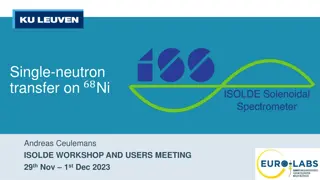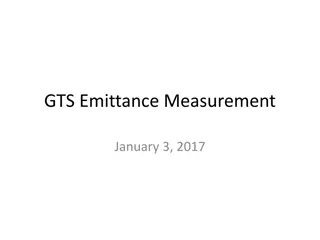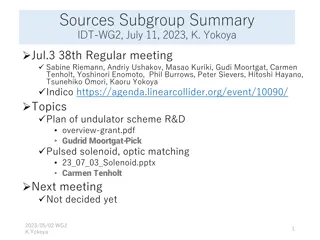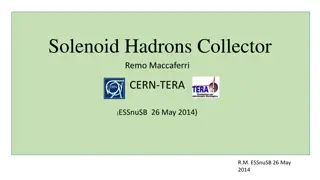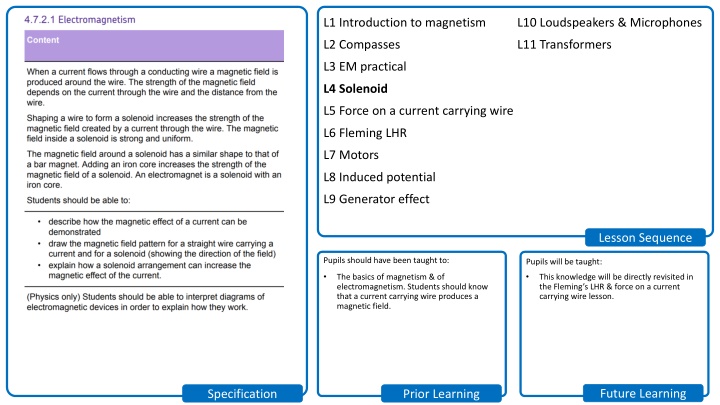
Solenoids: Basics and Applications
Explore the fundamentals of solenoids, including how they work, their practical uses, and how to enhance their magnetic field strength. Discover key concepts like the right-hand rule and the magnetic field characteristics of solenoids in this comprehensive guide to magnetism and electromagnetism.
Download Presentation

Please find below an Image/Link to download the presentation.
The content on the website is provided AS IS for your information and personal use only. It may not be sold, licensed, or shared on other websites without obtaining consent from the author. If you encounter any issues during the download, it is possible that the publisher has removed the file from their server.
You are allowed to download the files provided on this website for personal or commercial use, subject to the condition that they are used lawfully. All files are the property of their respective owners.
The content on the website is provided AS IS for your information and personal use only. It may not be sold, licensed, or shared on other websites without obtaining consent from the author.
E N D
Presentation Transcript
L1 Introduction to magnetism L10 Loudspeakers & Microphones L2 Compasses L11 Transformers L3 EM practical L4 Solenoid L5 Force on a current carrying wire L6 Fleming LHR L7 Motors L8 Induced potential L9 Generator effect Lesson Sequence Pupils should have been taught to: Pupils will be taught: The basics of magnetism & of electromagnetism. Students should know that a current carrying wire produces a magnetic field. This knowledge will be directly revisited in the Fleming s LHR & force on a current carrying wire lesson. Future Learning Specification Prior Learning
SciDoc Solenoids & uses Solenoids & uses Last Lesson Last Term Last Year Stretch & Challenge I do We do You do Test I do We do You do Do Now
SciDoc Solenoids & uses Solenoids & uses Keywords Learning Objectives Keywords Solenoid Coil Current Non-contact Circuit Complete Describe what a solenoid is. Recall how to use the right hand rule. Describe how electromagnets are used in common devices. I do We do You do Test I do We do You do Do Now
SciDoc T/N: Solenoids T/N: Solenoids A current flowing through a wire produces a magnetic field. This effect can be increased by having a coil of wire (called a solenoid). Stretch: What else could we do to increase the strength of the magnetic field? I do We do You do Test I do We do You do LO:
SciDoc T/N: Right hand rule T/N: Right hand rule Stretch: Where is the magnetic field strongest? Grip the wire with your right hand; thumb gives direction of the current. Your fingers curled around the wire will point in the direction of the magnetic field. I do We do You do Test I do We do You do LO:
A solenoid creates a field like a bar magnet. The field is strongest inside the solenoid. You can also use the right hand grip rule for a solenoid. SciDoc Stretch: How could we plot the direction of the magnetic field? I do We do You do Test I do We do You do LO:
SciDoc Task Task Complete the worksheet. I do We do You do Test I do We do You do LO:
SciDoc Basic/medium answers Basic/medium answers 1. A current flowing through it. 2. Bar magnet. 3. Solenoid. 4. Electromagnet can be switched off. 5. Steel becomes permanently magnetised. 6. Soft iron. 7. Increase the current, increase the number of turns in the coil. 8. Coil, arm, gong, off. 9. Steel, cable, off. 10.Relay, input, level, contacts. I do We do You do Test I do We do You do LO:
SciDoc Hard answers Hard answers 11. Switch in input circuit is opened, this breaks the circuit so current can no longer flow. This turns the electromagnet off and the iron lever releases the contacts. The breaks the circuit with the electric motor so that it also turns off. 12. Place plotting compass near the magnet on a piece of paper. Mark the direction the compass needle points. Move the plotting compass to many different positions in the magnetic field, marking the needle direction each time. Join the points to show the field lines. 13. Complete answer on other whiteboard. I do We do You do Test I do We do You do LO:
SciDoc Complete the task. You have 6 minutes. I do We do You do Test I do We do You do LO:
SciDoc I do We do You do Test I do We do You do LO:
SciDoc Struggle time! Struggle time! Exam question so exam conditions! You have 6 minutes! I do We do You do Test I do We do You do LO:
SciDoc I do We do You do Test I do We do You do LO:



